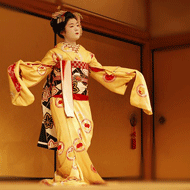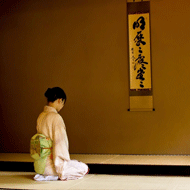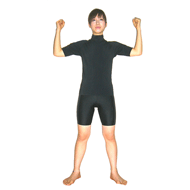|
The Japanese word "shisei" (姿勢) consists of two characters
the character for shape (姿)」
and
that for function (勢).
Shisei (姿勢) expresses
the aspects of a person's body, body/mind, and energy
at various times.
The Beauty of the Shisei Way
Shisei is a traditional Japanese practice that dates back
over a thousand years.
This did not only pass on simple etiquette such as demeanor and self-discipline. It also includes practical ways to achieve a stylish, yet healthy and robust, body with efficient movement.
We find many references to manners and etiquette in the two oldest historical records of Japan, the Records of Ancient Matters (Kojiki) and Chronicles of Japan (Nihon Shoki), and these are thought to be the start of what became the shisei way in Japan. Practical methods of developing a polite demeanor and enhancing physical ability began in the early Kamakura period (around the beginning of the thirteenth century).
Of course, Japan's national sport of sumo, and other traditional martial arts, performing arts and culture, such as, kyudo (Japanese archery), kendo, judo, karate, flower arrangement, the tea ceremony, noh, and kabuki, all start with a focus on posture. Japan is indeed a country with a shisei culture.
 
The Japanese word shisei (姿勢) did not exist before the Meiji period (1868-1912).
During the Meiji period, the Japanese translation of the German word "Körperhaltung" become shisei (姿勢).
In English "Körper" is translated as "body", and "haltung" as "posture". In Japanese, the word shisei now not only includes the meaning of posture (or position) of the body, but has also developed a deeper meaning that includes the attitude of the heart or emotions.
That is to say:
Körper means the body, and
haltung means posture.
Before the Meiji period, various Japanese words with subtle differences in meaning, such as the words for the way one carries oneself (shosa), demeanor (tachifurumai), and manners (gyougi) were used as required for each situation.
Even today, of course, the true meaning of the Japanese word shisei, and other related words, vary, influenced to a greater or lesser extent by the situation and the speaker's true feelings.
After the word shisei was first used as the translation of the German word Körperhaltung, it was mainly used with the meaning of the body. However, as it came to be used in daily life, it gradually acquired the connotations of the emotions and energy, from related words, such as, shosa (carriage or conduct), gyogi (behavior), reigi (manners), tachifurumai (demeanor), and shinjinichinyo (body, heart, and mind as one).
Today, as many Japanese already know, the word shisei has developed other connotations not only the meanings of adjusting one's physical posture and mental attitude, but also a philosophical backdrop that influences the structure, approach, and attitude of organizations, groups, and society in Japan.
* There are several other Japanese concepts that have influenced Shisei.
- Shosa (所作)
A Buddhist term that refers to the action and thoughts that invoke a movement. NB: In English this is translated as conduct or the way your carry yourself.
- Gyogi (行儀)
Manners or behavior. Originally this applied to rules for Buddhist practices.
- Reigi (礼儀)
Behavioral rules that help ensure smooth relations in society. This is often translated as courtesy or manners.
- Saho (作法)
Conventional practices used when doing something. Usually translated as etiquette.
- Tachifurumai (立ち居振る舞い)
Demeanor while carrying out daily activities, such as standing and sitting.
- Shinjindatsuraku (身心脱落)
Release from one's physical and psychological restraints. (This was originally used to refer to the state achieved after intense Zen practice.)
- Shinjinichinyo (身心一如)
Unity of the body, heart/mind, and energy in action.
References: Kojien, Taishukan's Yojijukugo (4-character compounds) Dictionary, Meikyo Japanese Dictionary, Kenkyusha Japanese-English Dictionary

The Benefits of Practicing Shisei
□ Physical Benefits
- Corrects abnormal curvature of the spine (scoliosis). Aids speedy recovery from osteoarthritis and other posture related disorders.
- Reduction, improvement, or elimination of posture related disorders.
- Improved movement.
- Increased physical power.
- Prevention or reduction of sports injuries.
- Improved figure.
- Reduction or elimination of spinal distortions.
- Elegant neckline.
- Reduction, improvement, or elimination of leg and foot problems, such as bow legs, knock knees, bunions, or fat/puffy legs.
- Provides an elegant way of carrying oneself.
□ Emotional and Mental Benefits
- Recovery from feeling out of sorts.
- Calming of anxiety or mood swings.
- Enhanced concentration.
- Increased affinity with others.
□ Everyday Improvements
- Deeper sleep, greater energy, and better balance.
- Improved digestion and bowel movement.
- More balanced approach to work, study, and recreation.
- More balanced approach to daily life.

Aiming to Obtain a Naturally Balanced Posture
Although we assume a posture when doing things, it is not necessarily the correct posture.
And that does not mean to say a twisted posture is good. It is important to achieve a balance between a balanced posture and distortion.
Natural movements usually manage to strike a balance between these two positions and help us live a healthy life.
The word "natural" here relates directly to natural (instinctive) movement. In other words, natural movements are ones that do not try to maintain a "correct" or an habitual posture all the time but react to maintain balance for that situation.
We should welcome these natural movements in a lively way with an open heart. These should help us develop a natural posture that promotes attractive proportions, is pleasant to practice, and brings a sense of vitality.
Dropping our Preconceptions
We should try to cast aside our preconceptions that a distorted posture is the same as having to maintain an upright posture all the time.
We humans are not robots.
We all have our own individual balance and movement.
We look out for any signals from our bodies about strains and distortions and calmly take notice of them.
First, we should observe our own movements closely.
Then we will discover we should do some of the following exercises.
• What Should We Do?
First, we should be conscious of our principle axes when assuming a posture.
Many movement, health, appearance, mental, emotional, and other problems start with a distorted posture, and can be remedied by adjusting one's posture.

* What are the Principle Axes?
These are the axes formed by the first, second, third, and central axes, which are arranged as three horizontal axes and one vertical axis. This looks like the Japanese character 主 (shu), which means principle or main.
They are therefore referred to as the principle axes in Shisei.
- • Central Axis
- An imaginary perpendicular line drawn from the top of the head (point where a line between the ears and midline meet) and the bottom of the pelvis (point in the perineum area where a line from the genitalia and anus meet).
- • First Axis
- Imaginary line connecting the coxa.
- (In practice, this is in the center of the hip joint.)
- • Second Axis
- Imaginary line connecting both humeri and greater tubercle of humeri. (In practice, this means the center of the shoulder joint.)
- • Third Axis
- Imaginary line running behind and between both ear lobes. Anatomically, this is known the atlantooccipital joint.
• Additional Points
We should get used to being relaxed when exercising.
First, we should be conscious of our principle axes when assuming a posture.
Have you heard the expression "Relaxation Exercises" (which is part of Shisai)?
Relaxation Exercises are subconscious actions, such as stretching your fingers, folding your arms, crossing your legs, and sitting sideways, that everyone does out of habit each day and can be done on one's own as part of an exercise program to correct posture.
(In technical terms, this is called Shisai in Japanese.)
While being aware of one's principle axes, Shisai Relaxation Exercises are ones that can be used to correct poor posture that do not rely on the helping hand of others, that are pleasant to perform, and are easy to do.
Link to Shisai Exercises
The Three Pillars of the Shisei Way
The Japanese word shisei does not
only mean posture.
It includes at least three meanings.
The first is physical posture.
The second is psychological attitude.
The third is spiritual condition (or energy level).
So the Japanese word shisei has all of the following connotations.
1 Physical Shisei (concerning the body) *1
1.1 Dynamic
1.2 Perceived
1.3 External
2 Psychological Shisei (concerning the heart and the mind) *2
2.1 Static
2.2 Imperceivable
2.3 Internal
3 Spiritual Shisei (concerning energy) *3
3.1 Dynamic-static interaction and balance
3.2 Perceived-imperceivable interaction and balance
3.3 External-internal interaction and balance

- *1 A person's physical body
- e.g. Computer hardware
-
- *2 A person's heart or psychology
- e.g. Software
-
- *3 A person's energy or spiritual power.
- e.g. The electricity that powers a computer
- This determines a person's source of life and spiritual power.
|




|











































